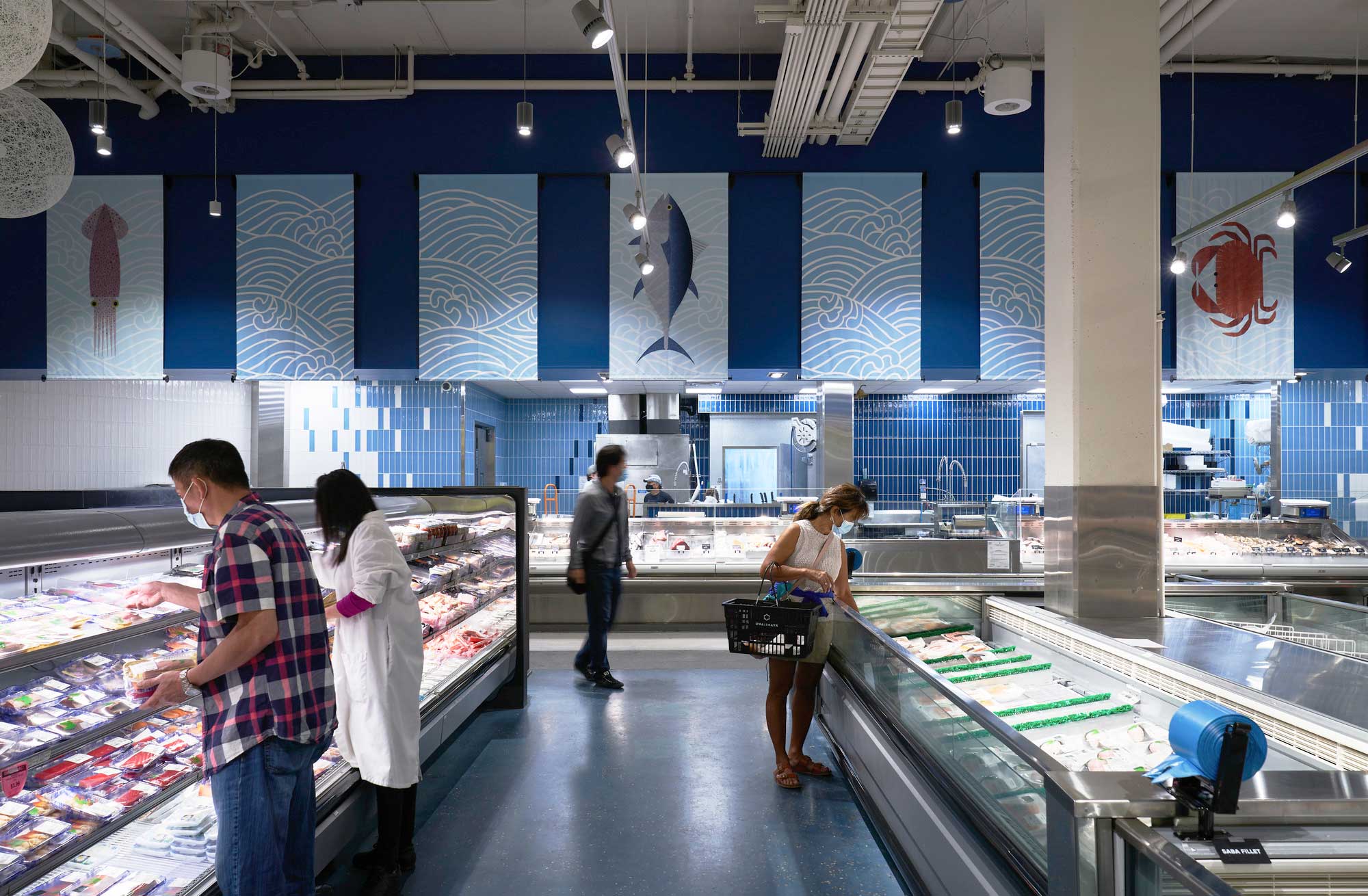Efficiency and sustainability fundamentally drive every system we design, and our vast portfolio includes more than 4,000 commercial refrigeration design projects. Some of our most groundbreaking work has included design of the first Ammonia/CO2 Cascade System in a grocery store in the U.S., and one of our designs earning the EPA GreenChill Partnership program‘s first Platinum rating for a grocery store.

Bringing Energy-Efficient Refrigeration Systems to Life
Refrigeration systems are a critical component of every grocery store design. And while their essential function has remained the same over time, their technology has not.
As systems age, they can cost more in energy and upkeep. If they malfunction, they can be a large, unexpected expense. Buying a new commercial refrigeration system is a sizeable investment, but also the opportunity to choose one that creates cost savings for the long-term and minimizes your environmental footprint. With each system, store, and budget dictating unique needs, how do you choose the right one?
At Cushing Terrell, we design efficient, sustainable systems. But more than that, we design efficient, sustainable systems tailored to you. Our goal is to understand your operational requirements and provide energy-reducing solutions that fit within your budget. We strive to turn opportunities into realized savings for our clients through the deployment of responsible energy solutions.
Why Cushing Terrell?
Full A/E Services Means Full Project Support
With one of the largest refrigeration engineering groups in the country, our knowledge and experience run deep. But we are more than refrigeration experts. We offer full A/E services with professionals licensed in all 50 states and Canada. Our integrated teams can advise on architecture, mechanical, electrical, and plumbing needs at any stage of a project. Knowing how a system will fit into a building means better up-front information and seamless project execution with no surprises.
At the Forefront of Thought Leadership
Our team of refrigeration designers and engineers bring leading-edge experience to the development of innovative refrigeration solutions. We do more than just stay current with available technologies; we have a seat at the table where next-generation ideas are discussed. We actively seek out, research, and employ new technologies that propel our clients into the future of natural and efficient refrigeration design.
Questions Answered, Technologies Explained
We stay on top of trends, technologies and regulations so you don’t have to. We can help you navigate the ever-changing regulatory landscape, new equipment and styles, and fluctuating costs. We break down what’s relevant to you and help identify the right path forward.
Sustainable Solutions
Sustainability has always been at the heart of what we do. We created the first Ammonia/CO2 Cascade system in a grocery store in the U.S., and one of our designs earned the EPA GreenChill Partnership program’s first ever Platinum rating for a grocery store. But we didn’t stop there. We continue to advance sustainable solutions for our clients. We offer store optimization services to minimize overall energy consumption and greenhouse gas emissions. Our goal is to understand your operational requirements and provide energy-reducing solutions that will fit within your budget. We strive to turn opportunities into realized savings for our clients through deployment of responsible energy solutions.
Our commitment to sustainability is longstanding. We invest significant resources into researching next-generation, “natural” refrigeration systems. We work with the U.S. Department of Energy, the EPA (Environmental Protection Agency), and NASRC (North American Sustainable Refrigeration Council) to advance public understanding of innovative systems. We are equipped to present solutions that are right for the environment and for businesses, both now and into the future.
Design For All Shapes and Sizes
No matter the age, size or scale of a commercial refrigeration system, we bring solutions. We partner with superstores and warehouse clubs for multi-location templates, as well as with small, boutique grocery stores looking for a one-time fix. Typical services may include standard design, coordination, and construction document development for permitting and bidding, to full-criteria development for large-scale programs.
Refrigeration Design: Thoughts from the Experts
- On our Good, Thoughtful Hosts podcast: Responsible Refrigeration with Nick Doherty
- On our blog: Refrigerant Technologies — The Options and Why they Matter
Contact us for:
Whether you have a new corner market or are replacing an entire system in an existing supermarket, we have the resources and knowledge to handle your grocery refrigeration project from start to finish. Our experts can advise you on selection of natural refrigerants or a traditional system, so you know you’ve made the right selection for your investment.
When your store is ready for an upgrade, we can help you identify good, better, and best options, considering factors such as cost, maintenance, environmental impact, and lifespan. We’ll advise you on whether you can upgrade part of your system if some of your equipment has not reached its end of life. Replacing one section at a time can help you achieve your goals over time, with less impact on your budget and store operations.
As one of the largest refrigeration engineering groups in the country, our knowledge and experience runs deep. Typical services may include anything from standard design, coordination, and construction document development for permitting and bidding, to full-criteria development for large-scale programs.
Cushing Terrell has developed a robust door retrofit program for open, multi-deck refrigerated cases. Our turnkey approach helps retailers identify what stores would benefit most from door retrofit, accounting for all the applicable weighted factors. Once feasibility is established, Cushing Terrell oversees the project start to finish, including utility incentive work, existing condition verification, refrigeration design, purchasing of doors, installation, refrigeration systems modifications, construction management, and commissioning.

Frequently Asked Questions
Rob Arthur, co-director of Cushing Terrell’s retail design studio and principal-in-charge of refrigeration engineering, answers your refrigeration questions.

What are some environmentally friendly refrigerant options?
The leading trend in the industry in the United States and even in Europe is utilizing CO2 as a refrigerant. The reason for that is it’s one of the cleanest as far as the system design and the components that are required. But ammonia and hydrocarbons are also good options.
How do you measure the environmental impact of a refrigerant?
The environmental impact of refrigerants is measured by their global warming potential, or GWP. Every refrigerant has some level of global warming potential. The current typical refrigerant most retailers are using in the United States has a GWP of around 1,300. Conversely, CO2 refrigeration has a GWP of one, and ammonia and hydrocarbon propane have a GWP of slightly less than one.
Are natural refrigerants more expensive than traditional options?
There isn’t one refrigerant specifically among the natural refrigerants that is significantly more or less expensive or requires a technology that is significantly more or less expensive. It really comes down to volume of systems and production. Since there is a trend toward CO2 refrigeration systems, they’re creating a volume, so the pricing is better with this type of system versus an ammonia CO2 system or a hydrocarbon propane system.
Ammonia vs. CO2: which is better?
The leading trend in the industry is to use CO2 as a refrigerant. It’s more like existing systems, with some slight modifications. Ammonia needs to be combined with CO2 or another refrigerant, and this creates more complexity. Ammonia is better in the desert or hot climates, where a CO2 system is less efficient. Advancements are being made to improve CO2 energy efficiency in hotter climates so it can be more competitive with a traditional system in that environment. The issue with ammonia is it can’t be run through an entire store like CO2 because of safety concerns in the event of a leak, so it must be kept outdoors or in a mechanical room and connected to another refrigerant, such as CO2.
Is there a way to retrofit existing refrigeration systems to be more sustainable?
Yes. The architecture of a CO2 system is not dramatically different than the systems we’re commonly using today. The most straightforward way to upgrade or remodel is to replace an entire system. But in stores that have equipment that has not reached its end of life, there is an option to update in sections.
Are significant changes happening in refrigeration systems used in grocery stores?
Both the types of systems and the types of refrigerants we’re using are changing. The industry is collectively moving toward natural refrigerants: ammonia, CO2 or carbon dioxide, and propane or hydrocarbons. A hundred years ago, those were the go-to refrigerants. We then shifted to synthetic refrigerants that didn’t have the same scale limitations that natural refrigerants have. But the synthetic refrigerants have negative environmental impacts, so we’re now looking back to these original refrigerants, which don’t affect the ozone layer and don’t accelerate global warming, but are just as efficient.


